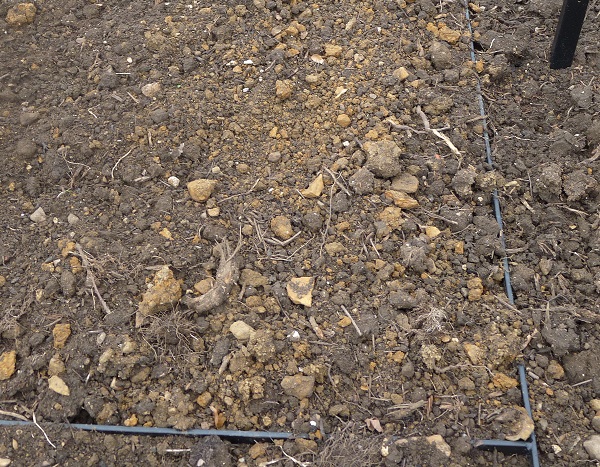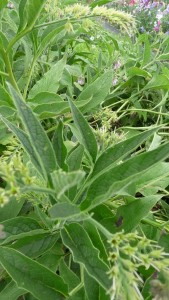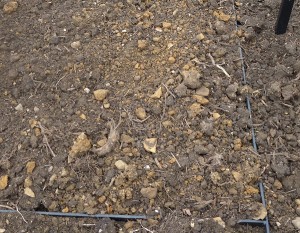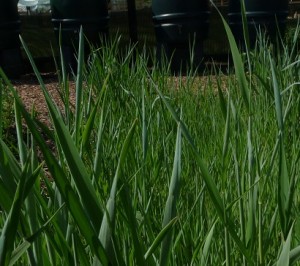
Soil is a very complex living thing. In just one gram there can be over a 1000 million organisms, most of them beneficial to the gardener. These organisms help weather rocks, releasing their mineral content for our plants and aid the breakdown of organic matter, in turn releasing further nutrients for our ever hungry crops. Recent studies have even suggested that some soil borne microorganisms may be more effective than antidepressants in boosting the mood of the gardener.
Most of these organisms live in just the top few centimetres of the soil, so leaving the ground exposed to the elements can mean they will be leached away, along with all the nutrients they may have freed up. I’ve seen many first time growers strip the ground bare and arduously dig it over, only to leave it exposed right across the winter. Leaving your soil exposed in this way for months on end allows the rain and wind to wash and blow away all these millions and millions of tiny allies living near the soil surface. In a very real sense, exposing your land to the ravishes of the winter weather is the best way of killing of anything beneficial that may be living within the top-soil.
With the exception of allowing a few frosts in to break up heavy clay (cover with black plastic and roll back when a frost is forecast), the soil should always have some kind of ground cover, be it living or artificial. This not only prevents nutrient leaching and erosion, a ground cover will also prevent the growth of weeds which can harbour pests and compete with your crops.
You can cover the ground in plastic or cardboard but a far better bet is to sow a green manure. Deep rooted green manure plants will help break up the soil and the roots of nitrogen fixing green manures can trap airborne nitrogen, improving the fertility of the soil. They can also be dug in to improve structure and provide a welcome boost to soil fertility. In addition they will provide a habitat to frogs, beetles, slow-worms and all manner of creatures which will prey on pests such as slugs and snails. So at first it may seem counter intuitive to grow something you’re not going to eat but, they can be sown at this time of year when there is little else growing.
Top Green Manures
Phacelia – Fast growing, good ground cover no problem in a crop rotation
Rye grass – Extensive roots help break up the soil
Tares – Nitrogen fixing, produce a lot of foliage which can be used as a mulch or whole plant dug in
Comfrey – not technically a green manure but makes an excellent plant feed
Field beans and broad beans – Nitrogen fixing, can be sown right through the autumn and again in the spring
Rye grass, Phacelia and mustard
All three of these green manures can be scatter sown, providing a thick carpet of plants which can be dug into the ground around four weeks before planting your vegetables. Mustard is a perfect green manure for ‘no dig’ plots as come the first frosts it will be killed off and left for the worms to take into the soil. However mustard is a member of the cabbage family and using it as a green manure can upset a crop rotation system. If you are not sure if this will affect your system then plant natural green manures such as phacelia or rye grass. August or early September as these are good times to sow both rye grass and phacelia, if you miss the window then cover your ground with cardboard or black plastic and sow as they weather warms up in March. It seems a shame to not allow Phacelia to flower as it produces a beautiful, firework of a flower bursting into a bright purple bloom. The flower acts as a beacon to bees and pollinators in the area and it is sometimes grown as wildlife plant. With that in mind it really doesn’t hurt to let a few of these flower and besides you can always collect next year’s seed saving you money in the long run. Rye grass or Hungarian grazing rye can be sown as late as early October in the North or late October in the South.
To scatter sow green manures –
- Clear away any remains of your crops, dig out any perennial weeds and hoe off any surface weeds
- Plant your seeds as per the packet instructions or scatter over the prepared bed using around 50g per square meter.
- You can lightly cover the seeds with a fine layer of compost or make sure they are all in contact with the soil before covering with a net to stop the birds getting to them before they germinate
- Re-sow any areas which haven’t germinated
- Leave the plants until the spring, if they start to flower before this, cut off the tops and dig in.
- Allow around four weeks for green manure plants to decompose before sowing your vegetables.
Tares
Like many members of the pea and bean family (Fabaceae or Leguminosae) tares are nitrogen fixers. Nitrogen fixing plants have a symbiotic relationship with a bacteria living in swollen parts of their roots known as nodules. In exchange for their home and a little food from the plant, these bacteria convert airborne nitrogen into a form the plant can use. Leguminous green manure plants therefore have the added benefit of adding extra nitrogen to the soil when they are cut and dug in.
You can scatter sow tares but I have had disappointing results from this method, they can become quite a large(ish) plants and you end up with clumps where a lot of them compete with each other and patches where there are none at all. Instead plant in rows allowing around 2.5 cm (1 inch) between seeds and around 15cm (6 inches) between rows. September is slightly late for sowing tares in Northern counties but you might want to chance it as the autumn has been fairly mild in recent years.
Broad Beans and Field Beans
Field beans are a smaller version of our common broad bean but rather than harvest the crop they are dug in before they flower in the spring. Broad beans can be treated in the same way and can be a useful way of using up any spare seed you may have lying around. If the broad bean is allowed to flower and fruit most of the valuable nutrients will be taken up by the growing bean rather than being held in the plant. If you do wish to grow them as a food crop you will gain a little organic matter and some nutrients by digging in the spent plants but ideally sow one bed as a green manure and one to eat. Both broad beans and field beans can be sown from September right until November at a spacing of 10cm apart with 20cm between rows.
Dynamic accumulators
Some plants have either very deep or very far reaching roots that seek out minerals which accumulate in the leaves. These plants are not technically a green manure but go by the name ‘dynamic accumulators’. Comfrey and borage both fit into the deep rooted side of this spectrum and nettles cover the far reaching side. When used in combination nettle and comfrey or nettle and borage can provide a balance of nitrogen, phosphorus and potassium (often marked as NPK on plant feeds) vital to your growing plants. They can be rotted down in bucket of water, or just used as a mulch around your plants. Comfrey can get a little out of hand and many gardeners will be digging it up around this time of year, so it’s a perfect time to get your hands on some of the roots. If possible try and plant bocking 14, a variety championed by Lawrence Hills, founder of HDRA. Find an unused patch of land, clear it of weeds and bury the root – comfrey is a pretty tough plant, so no matter how you plant it, come the spring it will start to grow into a nice big bushy plant.
Still not convinced?
The alternatives to green manures are of course to add farm yard manure or chemical fertilizers. A couple of years ago many allotment holders found their crops were dying on ground they had previously dug in farm yard manure. It later turned out that the manure contained residues of an herbicide known as Aminopyralid, a substance manufactured by Dow Chemicals. Growing your own manure eliminates the risk of this kind of contamination and can be a real bonus to vegetarians and vegans who may not wish to use animal by-products to raise their crops. If you’ve never grown them before perhaps consider growing some green manure and some leafy mineral accumulators on your plot, if they could all those soil microorganisms would thank you for it.
Article written by Dave Hamilton. Dave has now left Selfsufficientish but you can catch up with him on davehamilton.me.uk or on twitter @davewildish


